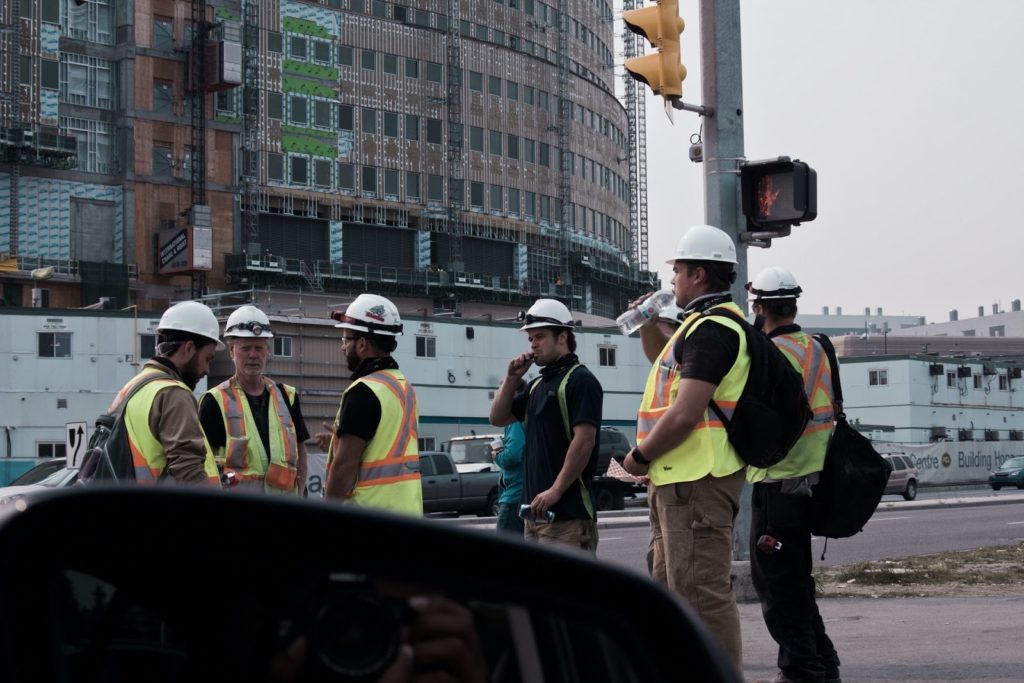
Construction is a major contributor to the U.S. economy. With around 680,000 employers and over seven million employees, construction workers help create nearly $1.3 trillion worth of structures every year. But along with those numbers, a glooming statistic looms: the United States Department of Labor says construction accounts for one in five annual worker deaths.
Known as the “fatal four,” the most common cause of fatalities for construction workers are falling, electrocution, being struck by an object, and getting caught between two objects. While accidents on the job site will happen, one wonders what these numbers would look like if every company prioritized a culture that promotes a stop work authority policy (SWA).

A stop work authority policy is a safety policy that allows employees to legally stop work on a project if they consider the environment or the task to genuinely endanger their well-being.
Unlike general business liability insurance or a plan to assist all parties once an accident has occurred, the goal behind such a SWA is to mitigate and prevent, when possible, such accidents from taking place. A SWA also encourages workers to feel safe, validated, and heard, removing all fear of company retribution, such as denied wages or job loss.
For a stop work authority process to be effective, the company must clearly define each party’s roles and responsibilities.
For a policy to work properly, the job site’s culture and environment must be conducive to honesty and openness. It’s one thing to have a SWA in place, but something entirely different to have a workforce that feels empowered to speak out and utilize the policies put into place. Morale boosts like check-ins or monthly team breakfasts can help build camaraderie and get employees invested and involved.
A stop work authority should be implemented whenever a worker genuinely feels they are about to enter or have already found themselves in a dangerous situation. Situations that may warrant issuing a stop work authority include, but are not limited to:
At the end of the day, the professional on the job site knows best. If someone on your team feels unsafe or is worried about the threat of imminent danger, it’s far better to call a quick time-out and reassess the situation than to plow through in the name of efficiency.

In the summer of 1974, two maintenance employees, Virgil Deemer and Thomas Cornwell refused to crawl out on a screen from which a co-worker had fallen and died nine days earlier.
Dissatisfied with their plant’s response — as their concerns fell largely on deaf ears — they were forced to punch out with six hours of their shift remaining. In light of this, Deemer and Cornwell would eventually take the company, Whirlpool Corp., to court.
The repercussions of this case eventually made their way to the U.S. Supreme Court and, on Feb. 26, 1980, the court issued a ruling that defined a worker’s right to refuse work if they feel they are genuinely endangering their lives.
The events that led to the Supreme Court’s rulings are, amongst other things, the result of a lack of clear expectations, communication, and understanding. Much of this could have been avoided with a stop work authority program.
Another reason a stop work authority process is important is because it helps prevent conflict on the job site. High-stress environments provide enough mental and physical taxation on employees as it is, let alone the animosity and frustration that can build when procedures are unclear.
Any decent foreman isn’t trying to put his team in danger, but if clear rules and procedures aren’t in place, it can be difficult to decipher the right call. All of this can lead to conflicts on the job site, preventing a team from working effectively and efficiently.
When it is in place, all parties can feel more comfortable about stopped work and hold-ups. This doesn’t necessarily mean everyone will reach an agreement right then and there, but it does provide a clear process that ensures the safety of everyone involved until a plan of action is put in place.
Another reason why a stop work authority is important is because it helps foster employee engagement. A major study found that engaged employees are 87% less likely to leave and creating a culture that values employee engagement is more likely to be profitable.
By clearly outlining company procedures, you can help keep work on track. Not only do clear procedures give peace of mind to workers and supervisors alike, but the clearer a task is, the more likely a team will rally behind it and help push the job to the finish line.
When employees don’t know what to expect, they often lose motivation. By establishing a stop work authority policy with clear procedures, you can free up your workers from worrying about their environment’s safety and allow them to focus on doing their jobs.
A fleshed-out stop work authority process is vital for a company’s health and the trust and respect of its employees. Without one in place, your entire chain of command — from supervisors to employees — lacks the clarity needed to know when enough is enough.

All stop work policies adhere to a similar structure. While exact terminologies differ from time to time, it’s absolutely essential to follow each of the steps below.
When a worker identifies a potentially dangerous condition or activity that could endanger themselves, their fellow workers, or equipment, a “Stop Work” intervention should immediately be put into place, allowing everyone potentially at risk to pause until a resolution is met.
Notify affected personnel of the stop work put into place, and halt all activities associated with the work area in question if necessary. Make the area(s) as safe as possible by removing all personnel.
Affected personnel will review and discuss the situation at hand. If all parties agree that the situation is safe to proceed, the SWA is complete, and the work may be resumed. If there are differing opinions on the safety of the activity or environment in question, it may be necessary to call someone higher up in the chain of command.
Before an employee(s) may restart work, all conditions that posed a threat must be modified and repaired to ensure the danger is no longer a threat. In alignment with the corrections outlined in the Stop Work Issuance Form, any updates to an affected area(s) should be made by the proper personnel.
When the affected area(s) has been inspected and deemed safe, work may resume. This should only happen after all corrective actions implemented have been made known to the affected personnel.
Following up with the correct personnel to monitor the effectiveness of the stop work policy’s changes is a crucial step in understanding if the issue has been correctly abated. It is prudent to ensure corrective actions were put into place and that they have effectively resolved the issue. If further investigation is necessary, corrective actions may be required to identify root cause issues.
As we touched on earlier, the lack of a SWA can lead to conflict. But aside from conflict resolution and the benefit of stopping work before a loss is experienced, a solid SWA promotes participation and partnership within a company.
By allowing your employees to voice their concerns, the safety team expands, and the process becomes more than a piece of paper, but rather an integral part of company culture.
A SWA helps dismiss the thoughts of an exclusively bottom line-focused company while creating an environment that seeks to ensure the safety and well-being of everyone on the job site. And while a quality workers’ compensation plan is a must for just about every industry, it’s better to establish a day-to-day plan that works to mitigate potential risk from the get-go.
Unfortunately, even with OSHA’s Worker’s Right to Refuse Dangerous Work, the American Society of Safety Engineers (ASSE) reports workers only speak up about 39% of the time. This isn’t a reflection of SWA as much as it is a revealing statistic on company culture.
Remember, a SWA only removes the fear of formal punishment and not the more pervasive fear of informal punishment and ridicule. A solid SWA should flow naturally from your company’s culture. Attempting to reverse-engineer company culture by expecting your SWA to create the kind of place that values workers and employees is not the correct way to go about it.
For all the benefits of a quality and comprehensive stop work authority policy, it’s best thought of as a last line of defense and not as the fix-all to every problem. Far too often, there is a tendency to elevate SWA to the job that safety managers should be doing. Remember, if you continuously have to implement it, there’s a bigger issue at hand that needs to be addressed.
This blog was originally published on May 14, 2020. It was updated on March 10, 2021.
This information contained herein is a general explanation of the topic and is not intended to be exhaustive nor should any discussion or opinions be construed as legal or professional advice. Readers should contact legal counsel or an insurance professional for appropriate advice as each policy and situation is unique and subject to differing policy terms, conditions, and exclusions.